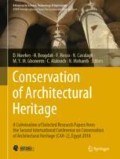Abstract
Nowadays, the recovery of industrial heritage can be considered as one of the most effective strategies of cultural regeneration and revitalization of the urban environment and its surroundings. This heritage of largely abandoned production sites represents the memory of a shared social and economic past. They must be returned to society as a collective cultural heritage, becoming an active part in the construction of sustainable development processes for the local communities. The reflection on the future of Penna brick factory—an imposing complex built in Sicily at the beginning of the twentieth century and currently in a state of total abandonment—is placed precisely in this perspective. The recovery proposal, which is described in the paper, is based primarily on a careful reading of the construction history of the building and of the production story, as elements to be enhanced in design choices. The local debate on the building’s future is lively and it has suggested the reuse as an eco-museum and a civic cultural center. The project proposal, which stops at a preliminary stage, is based on a bottom-up approach and aims, on the one hand, to revitalize the industrial site and on the other hand to re-launch tourism in this area through the activities of the cultural center.
Access this chapter
Tax calculation will be finalised at checkout
Purchases are for personal use only
Notes
- 1.
About the concept of industrial heritage as a historical material evidence of the production activity and about the recognition of the vestiges of industrial archeology as cultural heritage, see Battisti (2001), Tognarini and Nesti (2003), Papuli (2004), and Ciuffetti and Parisi (2012). About the history of Sicily’s industrial development, see Cancila (1995). For a critical reflection on the reuse of the industrial heritage in Sicily, see Sapienza (2014).
- 2.
About the diffusion of the Hoffmann furnace in Italy, see Siena (2012).
- 3.
The sansa is a by-product of the process of extraction of olive oil, composed of skins, pulp residues, and olive nugget fragments, which among its uses boasts that of heating fuel.
- 4.
Decauville railroads, born in 1875, are narrow-gauge railways, whose track consists of prefabricated elements that can be mounted and dismantled quickly. They are used almost exclusively for the carriage of goods such as minerals, wood, peat, clay, and sand.
- 5.
- 6.
In support to this intention, see Spaziante (2011).
- 7.
The new use as an eco-museum is considered particularly significant in the present proposal, because it is based on participatory planning as a conciliation tool and because it is in line with the most current territorial marketing strategies, which allow interpreting the true needs of a region, also through the enhancement of the genius loci, with the objective of a harmonious local development. See Caroli (2013) and Reina (2014).
References
Battisti E. Archeologia Industriale, Architettura, lavoro, tecnologia, economia e la vera rivoluzione industriale. Milano: Jaca Book, 2001.
Tognarini I, Nesti A. Archeologia industriale. L’oggetto, i metodi, le figure professionali. Roma: Carocci, 2003.
Papuli G. Archeologia del patrimonio industriale. Il metodo e la disciplina. Perugia: Crace, 2004.
Ciuffetti A, Parisi R. L’archeologia industriale in Italia. Storie e storiografia (1978–2008). Milano: Franco Angeli, 2012.
Cancila O. Storia dell’industria in Sicilia. Roma – Bari: Laterza, 1995.
Sapienza V. Riuso e conservazione nell’archeologia industriale in Sicilia. Roma: Aracne editrice, 2014.
Savà G. Il contratto che non c’era e la fabbrica fantasma. Giornale di Scicli 1999a; 9: 6.
Siena G. Il girotondo del fuoco. Le fornaci Hoffmann circolari in Italia. Macerata: Edizioni Simple, 2012,
Savà G. Mio padre e il suo amore per il Pisciotto: storia di un’impresa. Giornale di Scicli 1999b; 9: 6–7.
Firrone T. La fornace di pietra a Marsa Siklah. Roma: Aracne editrice, 2013.
Bellia P. La fornace del Pisciotto quale destino. Giornale di Scicli 1989; 29: 4–5.
Bellia P. La problematica dell’intervento. Giornale di Scicli 1995; 25:7.
Firrone T. The brick furnace of Pisciotto Country, in Scicli. In Carmine Gambardella, World heritage and disaster. Knowledge, Culture and Representation, XV International Forum of Studies “Le Vie dei Mercanti”, Naples - Capri 15–17 June 2017. Napoli: La scuola di Pitagora editrice, 2017, p. 48-57.
Drago P. Un albergo nell’ex fornace Penna. Perché no? Dibattito 2003; 3: 6.
Savà G. La Fornace albergo a 5 stelle? Giornale di Scicli 2003; 3.
Parisi R. Industria, memoria, patrimonio. Per un’archeologia del riuso. Patrimonio industriale 2009; 4: 4–5.
Vitale A. Il ruolo delle conoscenze tecniche nel progetto di recupero dell’edificio industriale. Patrimonio industriale 2013; 11: 20–23.
Spaziante A. Il riuso del patrimonio industriale come contributo alla rigenerazione responsabile del territorio. Patrimonio industriale 2011; 7: 20–26.
Caroli M. Il marketing territoriale. Strategie per la competitività sostenibile del territorio. Milano: Franco Angeli, 2013.
Reina G. editor. Gli ecomusei. Una risorsa per il futuro. Venezia: Marsilio, 2014.
Silvetti P. How an Museo Etnografico is born: a historical outline and a short guide to the Museo Etnografico of the New Mill of Settimo Torinese. Settimo Torinese: Ecomuseo del Freidano, 2007.
Land-Based Rationalism D-R-C. Zhujiadian Brick Kiln Museum/Land-Based Rationalism D-R-C. ArchDaily 04 Jan 2018. Online. Available: https://www.archdaily.com/886538/zhujiadian-brick-kiln-museum-land-based-rationalism-d-r-c/.
Author information
Authors and Affiliations
Corresponding author
Editor information
Editors and Affiliations
Rights and permissions
Copyright information
© 2019 Springer Nature Switzerland AG
About this chapter
Cite this chapter
Garda, E., Longo, M.L., Mangosio, M. (2019). Penna Brick Factory at Scicli: A Proposal for a Sustainable Reuse in Sicily. In: Hawkes, D., et al. Conservation of Architectural Heritage. Advances in Science, Technology & Innovation. Springer, Cham. https://doi.org/10.1007/978-3-030-10871-7_20
Download citation
DOI: https://doi.org/10.1007/978-3-030-10871-7_20
Published:
Publisher Name: Springer, Cham
Print ISBN: 978-3-030-10870-0
Online ISBN: 978-3-030-10871-7
eBook Packages: Earth and Environmental ScienceEarth and Environmental Science (R0)

